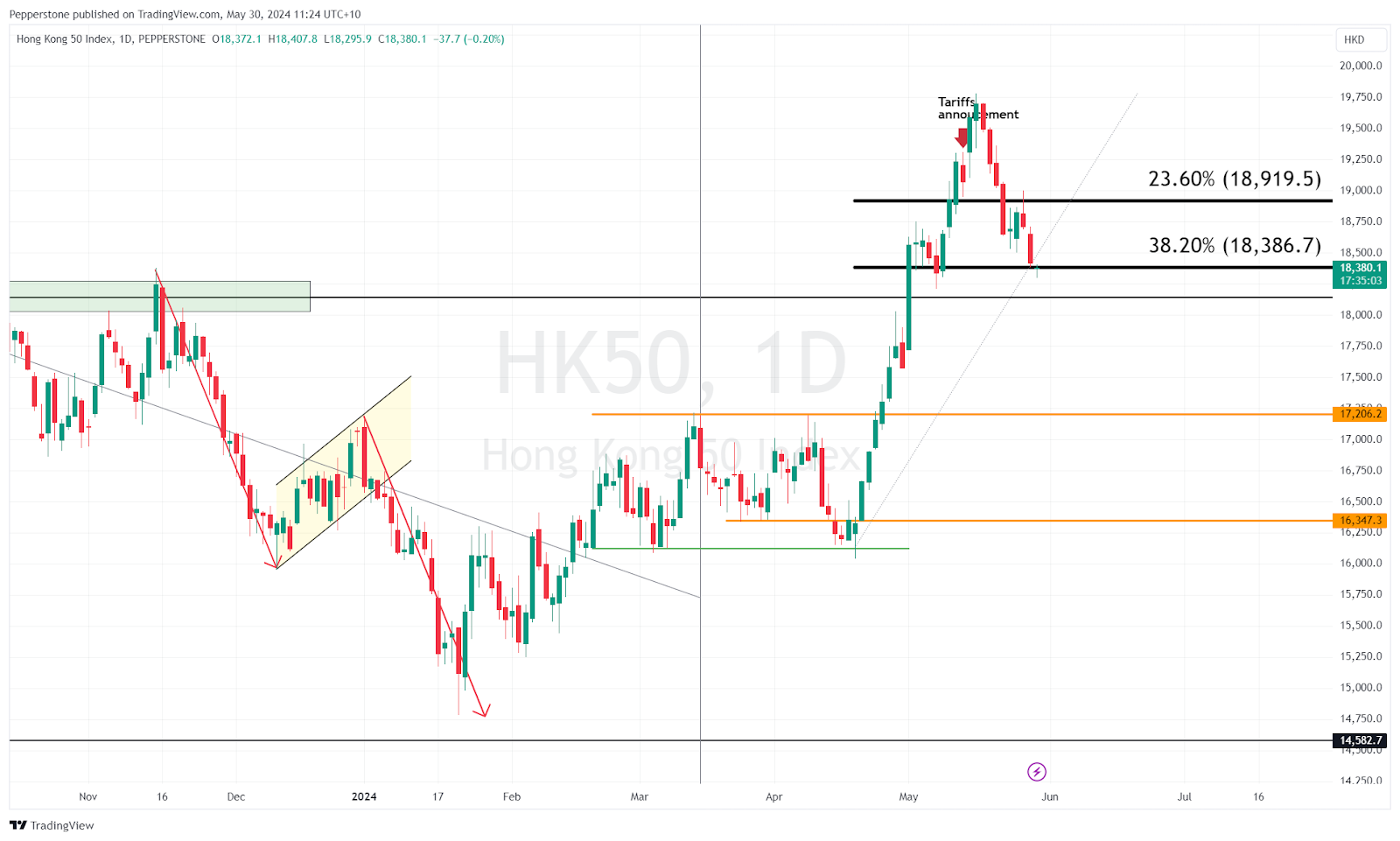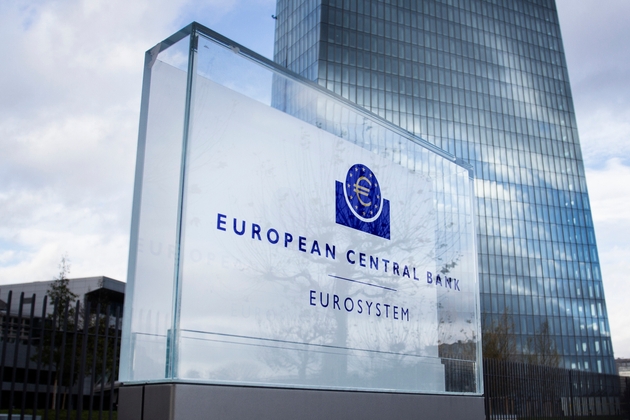- English
- عربي
US imposes tariffs on Chinese electric vehicles: China is ready to strike back
.jpg)
Despite this negative news, the market reaction was limited. On the day of the announcement, the CN50 and HK50 indices fell only 0.46% and 0.84%, respectively. Notably, this news did not halt the HK50's upward momentum from mid-April to mid-May, as the index closed at a cycle high of 19,697.6 two days later.

While the initial impact hasn't caused market panic, we still need to consider: How significantly will the increased US tariffs affect China's EV industry? If the US tariff hike prompts other economies to adjust their tariff policies towards China, what challenges will this pose for China's economic development? And how likely is China to retaliate?
The Rise of China's Electric Vehicle Industry
A decade ago, Chinese authorities declared that "the path to becoming a strong automaking nation lies in developing new-energy vehicles." With continuous policy support and technological advancements by domestic automakers, China has steadily expanded its lead in the electric vehicle sector.
In 2023, China's production and sales of EVs both approached 9.5 million vehicles, marking the ninth consecutive year it led the world, with a market share of 31.6%. Moreover, EVs are increasingly becoming a major driver of China's export growth. Last year, EV exports reached 1.773 million vehicles, a 67.1% YoY increase. And in the first quarter of 2024, export growth accelerated by 23.8% YoY, contributing 4.3% to the annual trade surplus.
Five years ago, when we mentioned new energy vehicles, the first name that came to mind was likely Tesla. But now, the key names have quietly shifted to BYD and NIO, among others.
Take BYD as an example: its sales in Q4 2023 surpassed Tesla for the first time, making it an undisputed global giant in New Energy Vehicle (NEV) and battery production. In Q1 2024, BYD's net profit increased by 10% YoY, and revenue grew by 4%. Although these figures fell short of market expectations due to significant price cuts, reduced battery costs and a 70% YoY increase in R&D expenses pushed its gross margin to a historic high of 21.9%.
Overall, China's EV industry is developing rapidly, with homegrown brands like BYD showing strong competitiveness in the global market. This growth is crucial for boosting exports and supporting China's economic development.
Short-Term Impact Limited, Strong Political Undertones
The immediate effect of the US tariff hikes on China's economic growth is minimal, as the US isn't a primary destination for Chinese EV exports.
The US only represents less than 2% of China's electric vehicles, integrated circuits, and solar cell exports. The increased tariffs only affect about 4% of China's annual exports to the US and 0.5% of its total exports in 2023. While tariff adjustment also impacts companies using Mexico as a gateway to the North American market, China's focus on the EV industry is evidently not on the US.
Compared to domestic Chinese automakers, the tariff hikes affect Tesla, Volvo, and German "BBA" brands more significantly. They produce components and assemble vehicles in China but have a substantial customer base in the US.
In my view, the US tariff increase on various Chinese goods carries more political weight than practical impact. With presidential elections approaching, the Biden administration aims to gain favor with voters by taking a tough stance on China.
Policy Spillover Effects and Long-Term Growth Constraints
Expanding trade restrictions to other regions could pose limitations on China's long-term growth prospects.
The Eurozone and the UK, being major import destinations, collectively represent 35% to 53% of China's exports in EVs, lithium-ion batteries, and solar panels. Their stance and actions hold much more weight than those of the US.
Currently, opinions within the EU vary widely: the Italian Minister of Industry suggests the EU should follow the US in imposing tariffs on Chinese goods, the French President emphasizes "buying European," while opposition in Germany is prevalent.
On June 5, we await the preliminary findings of the European Council's anti-subsidy investigation into Chinese EVs. Should it hint at intentions to impose tariffs, potential import-related inflation could pose a significant threat to the fragile European economy. Simultaneously, market concerns may arise regarding the sustainability of boosting the Chinese economy through exports and the new energy industry.
Considering the upcoming US election in November, a victory for Trump might lead to a broad tariff increase on all US imports to 60%, not solely targeting Chinese goods. In today's highly interconnected global trade system, such broad trade barriers could have a substantial impact on major economies, including China.
On June 27, during the first U.S. presidential election debate, Biden is likely to address the tariff adjustment, while Trump's stance may be even more aggressive. This event will likely provide greater clarity on the future trade environment.
In summary, the U.S. tariffs on China may influence the Eurozone's stance, presenting one of the risks China needs to consider in the second half of the year. Negative impacts on investor sentiment and potential limitations on the upside of related indices like CN50 and HK50 could result from such developments.
US Takes Hardline Stance, Will China Retaliate?
There are some chatters on the street that Chinese authorities are considering raising tariffs on high-displacement vehicles imported from the US and Europe, from the current 15% to 25%. At the same time, China has hinted at possible tariffs on European wine and dairy products.
Looking back, in July 2018 during Trump's presidency, tariffs of 25% and 10% were imposed on all imported steel and aluminum, respectively. In response, China imposed a 25% import tariff on an equivalent scale of US products on the same day.
In terms of applicable scope, the previous tariff adjustment affected approximately $350 billion worth of Chinese imports, significantly higher than the $18 billion impacted by the current situation.
I believe the authorities will not stand idly by, but if Europe does not take further action, the urgency for intervention objectively appears low. Coupled with the recent issuance of special government bonds and measures to boost the property market, policymakers may focus on domestic economic development while addressing external pressures.
Related articles
The material provided here has not been prepared in accordance with legal requirements designed to promote the independence of investment research and as such is considered to be a marketing communication. Whilst it is not subject to any prohibition on dealing ahead of the dissemination of investment research we will not seek to take any advantage before providing it to our clients.
Pepperstone doesn’t represent that the material provided here is accurate, current or complete, and therefore shouldn’t be relied upon as such. The information, whether from a third party or not, isn’t to be considered as a recommendation; or an offer to buy or sell; or the solicitation of an offer to buy or sell any security, financial product or instrument; or to participate in any particular trading strategy. It does not take into account readers’ financial situation or investment objectives. We advise any readers of this content to seek their own advice. Without the approval of Pepperstone, reproduction or redistribution of this information isn’t permitted.

